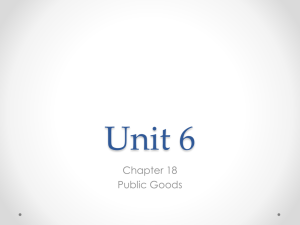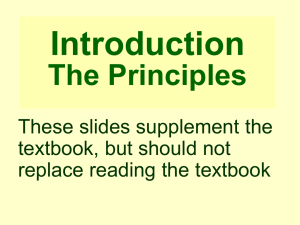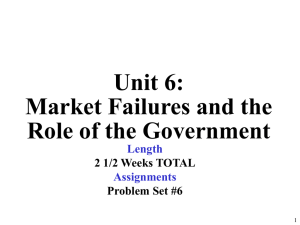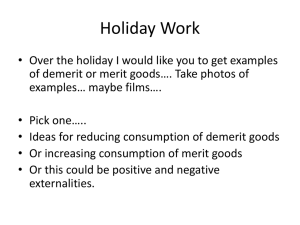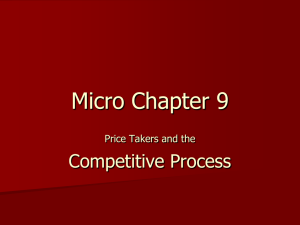Public Goods
advertisement
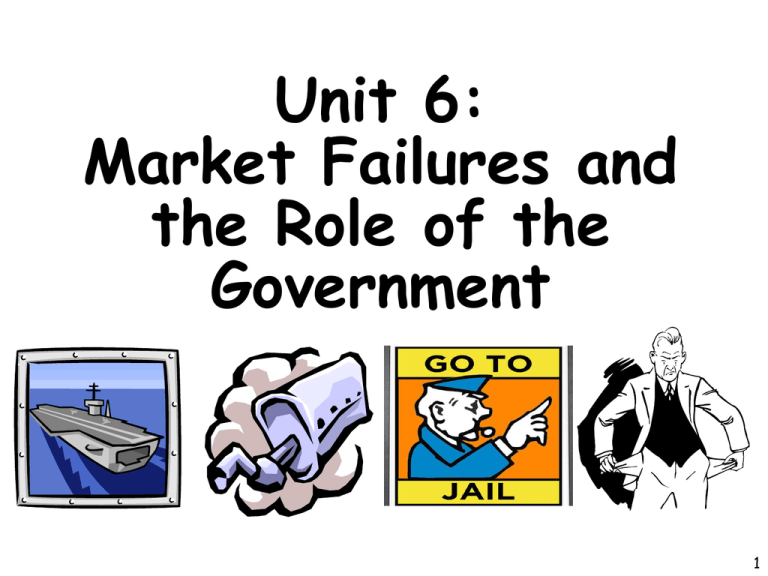
Unit 6: Market Failures and the Role of the Government 1 When should the government get involved in the economy? Worker Safety Laws Barber Shop Licenses Bank Bailouts Every society needs to decide how much government involvement is desirable 2 3 What is the Free Market? (CAPITALISM) 4 5 Characteristics of FREE MARKETS 1. Little government involvement in the economy. (Laissez Faire = Let it be, by Adam Smith) 2. Individuals OWN resources and determine what to produce, how to produce, and who gets it. 3. The opportunity to make PROFIT gives people INCENTIVE to produce quality items efficiently. 4. Wide variety of goods available to consumers. 5. Competition and Self-Interest work together to regulate the economy. The government’s job is to enforce contracts, secure property rights, and defend the country. 5 The INVISIBLE HAND of the FREE MARKET: If society wants computers and people are willing to pay high prices then… Businesses have the INCENTIVE to start making computers to earn PROFIT. This leads to more COMPETITION. Which means lower prices, better quality, and more product variety. To maintain profits, firms find most efficient way to produce goods and services. The government does NOT need to get involved since the needs of society are automatically met. 6 Does the Free Market ever FAIL to meet society’s needs? 7 What is a Market Failure? A situation in which the free-market system fails to satisfy society’s wants. (When the invisible hand doesn’t work.) Private markets do not efficiently bring about the allocation of resources. What’s the result… The government must step in to satisfy society’s wants. 8 How does the free market FAIL? 11 The Four Market Failures We’ll focus on 4 different market failures: 1. Public Goods 2. Externalities (3rd person side effects) 3. Monopolies 4. Unfair distribution of income In each situation, the government will step in to allocate resources efficiently. 12 Market Failure #1: PUBLIC GOODS Definition of Public Goods To be considered a true public good, it must meet two criteria: 1. Non-exclusion •Everyone can use the good. •Cannot exclude people from enjoying the benefits (even if they don’t pay). •Ex: National Defense 2. Shared Consumption (Non-rivalry) •One person’s consumption of a good does not reduce the usefulness to others. •Ex: Public Park 14 Identify which of the following is TRUE public goods (have non-exclusion & non-rival consumption): A. B. C. D. E. Hamburgers Satellite TV Homes D Street lights Public transportation 15 Private vs. Public Goods Private Goods • Exclusion possible • Can not be shared • Bought in marketplace Public Goods • Non-exclusion • Shared consumption • Bought through the use of tax dollars Private, Public, or Mixed Goods • Haircut • Auto airbags • College Education • Spraying for mosquitos • National Defense • Canine rabies shots • Cable television • Street Lights • Health Care • Toothbrush • Police and Fire Protection • National Forest Campgrounds • Potato Chips • Public toll roads Public Goods If there was no government, how would schools, parks, and freeways be different? Would there be enough to meet our needs? Video: Fire Department Auction 18 Public Goods Why must the government provide public goods and services? It is impractical for the free-market to provide these goods because there is little opportunity to earn profit. This is due to the Free-Rider Problem 19 What’s wrong with this picture? 20 The Free Rider Problem Free Riders are individuals that BENEFIT WITHOUT PAYING. Examples: 1. People who download music illegally 2. People who watch a street performer and don’t pay 3. Teenagers that live at home and don’t have a job 21 Does anyone free ride off you? 2012 Global Military Spending: Canadian $22.5 Billion US $645.7 Billion Why doesn’t Canada spend more on their military? 22 What’s wrong with Free Riders? Free-Riders keep firms from making profits. If left to the free market, essential services would be under produced. To solve the problem, the government can: 1. Find new ways to punish free-riders. 2. Use tax dollars to provide the service to everyone. 23 The Final Exam • I am willing to give an 100% on the final exam to whichever class gives me $3000. • Everyone in the class will get 100% even if they don’t pay. •Who is willing to pay? •What about those that refuse to pay? Solution? EVERYONE pays a mandatory tax and all receive the same benefits. 24 How do we decide how many public goods we need? Can the government… 1. Prevent wild fires in San Diego forever? 2. Ensure that no one ever speeds on the freeway? 3. Create a research station on Mars? 4. Stop pollution from fossil fuels? 5. Completely stop illegal immigration? 6. Make sure everyone in the US has a job? YES! But the costs outweigh the benefits. How does the government decide how many public goods to provide? How does the government determine what quantity of public goods to produce? They use Supply and Demand 1. Demand for Public GoodsThe Marginal Social Benefit of the good determined by citizens willingness to pay. 2. Supply of Public GoodsThe Marginal Social Cost of providing each additional quantity. Video: Dam Tragedy Demand for a New Park Marginal willingness to pay higher taxes # of Parks 1 2 3 4 5 Luis is willing to pay Jesus is willing to pay $4 $3 $2 $1 $0 $5 $4 $3 $2 $1 Society’s Marginal Assume: Social Demand 1.(MSB) There are only Cost two people in society. $5 $9 2.$7 Each additional $5 park costs $5 $5 $5 How many parks $3 $5 should be made? $1 $5 Supply and Demand for Public Parks The Demand is the equal to the marginal benefit to society Price 1. What if the government made 1 park? $9 2. What if the government made 4 parks? 7 MSB = MSC S=MSC The supply is the public good’s marginal cost to society 5 3 1 0 D=MSB 1 2 3 4 5 Quantity of Parks Review 1.List the characteristics of the Free Market. 2.Define Market Failure. 3.What is the “invisible hand”? 4.List the 4 Market Failures. 5.Why must the government provide public goods? 6.Define Free Rider. 7.What is wrong with having free riders? 8.List 10 streets in by 32nd St/ USC CAT. 29
